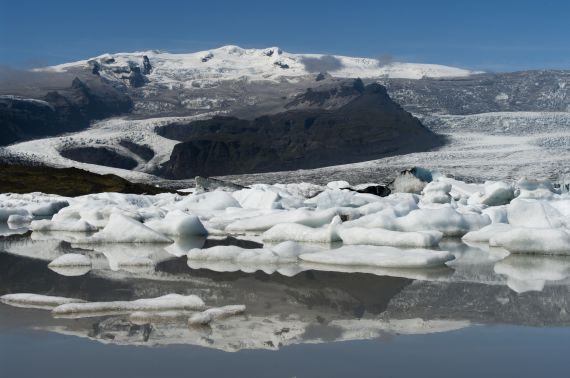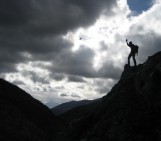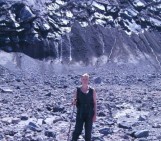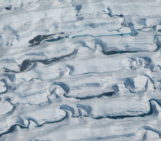This week’s Imaggeo on Mondays is brought to you by Joanna Nield, a lecturer in physical geography at the University of Southampton. Nield explains how volcanic eruptions can impact glaciers and how ash fall can both accelerate and slow down glacial melt…

“Fjallsjökull after the 2011 Grímsvötn eruption” by Joanna Nield, distributed by the EGU under a Creative Commons licence.
This photo was taken at Fjallsjökull, Iceland in July 2011, shortly after the eruption of Grímsvötn volcano (21 – 30 May 2011). The Grímsvötn volcanic eruption partially covered many of the surrounding glaciers in a spatially variable layer of tephra ash.
Fjallsjökull (and Hrútárjökull, the smaller lobe on the left of this photo) were south-east of the volcano, exposing them to the dominant wind moving the ash plume and the subsequent ash fall. We were lucky enough to use terrestrial laser scanning to study the impact on nearby Svínafellsjökull soon after the eruption with funding from the Royal Society – our daily surface measurements showed that shortly after an eruption, ice melt rates could be reduced by as much as 59% compared to clean ice model predictions.
When ash covers an ice surface, it changes the rate that snow and ice is lost from the glacier (the ablation rate). Dark coloured ash will reduce the albedo (reflectiveness) of the surface, causing it to absorb more heat. This causes an increase in melt rates for thin debris layers, but thick layers of ash insulate the ice and reduce melt. On top of this, complex feedbacks between debris cover, meltwater and surface shape redistribute ash and change surface roughness – which also influences ablation rates. It is important to understand these ash-ice interactions as well as feedbacks between the surface and atmosphere to better quantify the impact of volcanic eruptions in glaciated landscapes.
By Joanna Nield, University of Southampton
References:
Nield, J.M., Chiverrell, R.C., Darby, S.E., Leyland, J., Vircavs, L.H., Jacobs, B.: Complex spatial feedbacks of tephra redistribution, ice melt and surface roughness modulate ablation on tephra covered glaciers. Earth Surface Processes and Landforms, 38: 95-102, 2013
Nield, J.M., King, J., Wiggs, G.F.S., Leyland, J., Bryant, R.G., Chiverrell, R.C., Darby, S.E., Eckardt, F.D., Thomas, D.S.G., Vircavs, L.H., Washington, R.: Estimating aerodynamic roughness over complex surface terrain. Journal of Geophysical Research – Atmospheres, 2013
The EGU’s open access geoscience image repository has a new and improved home at http://imaggeo.egu.eu! We’ve redesigned the website to give the database a more modern, image-based layout and have implemented a fully responsive page design. This means the new website adapts to the visitor’s screen size and looks good whether you’re using a smartphone, tablet or laptop.
Photos uploaded to Imaggeo are licensed under Creative Commons, meaning they can be used by scientists, the public, and even the press, provided the original author is credited. Further, you can now choose how you would like to licence your work. Users can also connect to Imaggeo through their social media accounts too! Find out more about the relaunch on the EGU website.





Pingback: ESD research makes EGU news | ESDsoton
John Stevenson
Nice image. You can also read my post about a trip to the crater to see the effects of tephra on the snow and ice higher up.
http://all-geo.org/volcan01010/2011/08/grimsvotn-1-crossing-glacier/